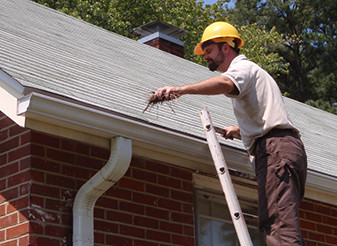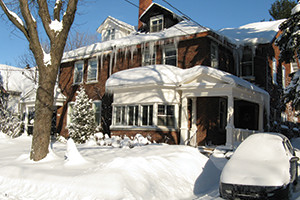For those living in cold climates, winter fun includes building snowmen outside and warming up inside with a cup of hot chocolate. But before the snow flies, you’ll need to get your home ready for winter. Find out ways to winterize your home, so your family stays both warm and safe this season.
Preparing for winter runs the gamut from making sure your home isn’t losing heat, to cleaning up outside, and preventing mold and mildew buildup. Before you’re ready to get out the sleds and enjoy the winter, prepare for the conditions winter will likely bring.
Read on to find out five ways to effectively winterize your home, and why each is important.
- Have your heating system inspected
Your heating system needs to be safe and efficient, not only to keep you warm, but also to keep your family safe. Inspecting your heating system is best left to professionals who know what to look for. Schedule your inspection in the fall, before winter truly sets in and your heating system is in use.
An inspection of your home heating system should include checks of:
- Carbon monoxide detectors
- Chimneys, flues, and vents
- Over-temperature switches
- Your heat exchanger
- Air filter condition
- Ducting and piping
- Propane/oil tanks
- Motor and fan (check and clean)
- Furnace internal area (check and clean)
- For forced-air systems, the motor and fan (check and clean)
- The furnace (test starting it and check thermostat function)

- Prepare the outside of your home
While it’s the inside of your home that you want to stay toasty warm, shoring up the outside of your house is the best way to accomplish this task.
Here’s your outdoor checklist for winterizing your home:
- Check for cracks around windows and doors, fill with caulk
- Check for gaps around wires, pipes, and cables, fill with spray foam
- Drain and winterize your irrigation system’s backflow preventer
- Check the flexible boots around any plumbing vents on your roof for cracks or failure
- Apply weather stripping around windows and doors

- Clean outside your home
The time to clean up outside your home is now, before winter sets in and you find your yard under a blanket of snow. Don’t get lazy and leave those pesky leaves around. You’ll be thankful (and so will your grass) come springtime.
Pick a nice fall day or two and accomplish these tasks:
- Inspect your roof. If you can do so safely, head onto your roof to check for broken, missing, cracked, or curled shingles. Replace any compromised shingles, or hire a roofer or handyman to do it for you.
- Inspect gutters. Autumn leaves have a habit of finding their way into your gutters. Clean leaves and other debris from your gutters, and make sure water drains properly. If you don’t have them already, consider getting gutter guards to prevent build-up.
- Trim trees and bushes. Take a look around your property and look for overgrown bushes or trees, or dead limbs. Pay attention to greenery right against your house, too, as overgrown shrubs can cause and hide mold and mildew growth on your house.
- Fertilize the lawn. Fall is the best time of year to fertilize your lawn, providing your grass with the nutrients needed to survive the winter and thrive in spring.
- Winterize your lawnmower. When mowing season is over, don’t just breathe a sigh of relief and park your lawnmower. You’ll need to remove all fuel by either running the machine empty or draining the gas tank.

- Lower the humidity
A little humidity in the wintertime can’t hurt, right? Wrong. Imbalances in humidity levels in your home can cause mold and mildew buildup. Use a humidity sensor to check the humidity levels in different parts of your house.
– When the outdoor temperature is between 14 and 32 degrees Fahrenheit, relative humidity indoors should be from 20 to 25 percent.
– When it’s -4 degrees to 14 degrees, humidity should be from 15 to 20 percent
If your home is too damp, use a dehumidifier to get the levels back down to normal.
How does having the right humidity levels in your home help you? Normal humidity levels reduce allergy risk, carry less toxins, don’t promote mold and mildew, provide a more pleasant atmosphere, and lower heating costs.

- Prevent energy loss
A great way to prevent energy loss is to use window coverings or insulators, as the glass in windows doesn’t slow the transfer of heat. This is an important way to prevent energy loss in cold climates, and in homes with a lot of windows.
One option is to use heat-shrink plastic over the windows. The plastic is attached to the frame around the window, and a hair dryer is used to shrink the plastic to the correct size.
You can also outfit your windows with thermal drapes or insulated shades. Thermal drapes work best when hung as close to the glass as possible, while insulated shades hang directly over the glass. When choosing a product, look for one with a high R-value.
Now that you’ve learned ways to winterize your home, do some further reading on lifesaving safety tips for winter. Most important, have a safe and fun season!
Photo Credit to: Robbie Sproule jasleen_kaur,




